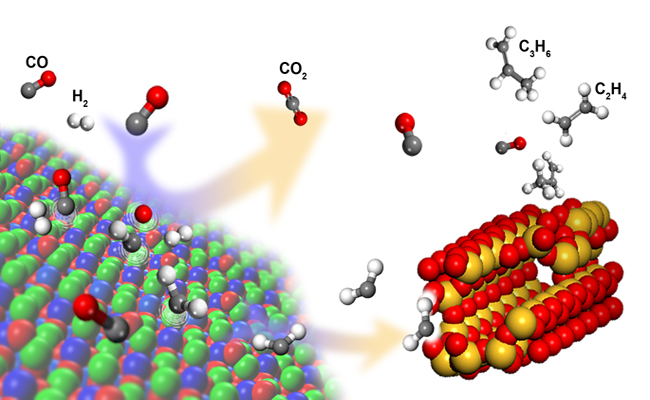Dalian Institute of Chemical Physics (DICP) research team led by Prof. BAO Xinhe, member of the Chinese Academy of Sciences and Prof. PAN Xiulian developed a nanocomposite, which can directly catalyze the conversion of synthesis gas to light olefins.
The composite catalyst affords two types of active sites with complementary properties. The partially reduced oxide surface (ZnCrOx) activates CO and H2, and C-C coupling is subsequently manipulated within the confined acidic pores of zeolites. Thus, the surface polymerization of CHx was circumvented. This leads to a high selectivity of light olefins (80%) and light hydrocarbons C2-C4 (94%) at carbon monoxide (CO) conversion of 17%. The C2-C4 selectivity is far beyond the maximum predicted by the Anderson-Schulz-Flory (ASF) model in Fischer-Tropsch synthesis (FTS).
It is well-known that, Fischer-Tropsch synthesis (FTS) is a traditional process to convert synthesis gas (a mixture of CO and H2) into hydrocarbons. It was invented over 90 years ago and is still in industrial practice to date for producing synthetic lubricants and synthetic fuels. The process involves CO and H2 activation over metal surfaces, forming CHx mononer. However, these mononers go through surface polymerization leading to formation of a wide range of hydrocarbons with different chain lengths. As a result, the selectivity to C2-C4 hydrocarbons, including paraffins and olefins containing two to four carbon atoms, cannot exceed 58%.
Further, in the new process, the surface oxygen from dissociated CO is removed by reacting with CO forming CO2. It may allow use of coal- and biomass-derived syngas with a low H2/CO ratio and thus there is no necessity for water gas shift (WGS), which could reduce both water and energy-consumption. These findings may open up a new avenue for development of not only syngas-to-olefin technology but also other processes.

The catalytic process of nanocomposite from synthesis gas to light olefins (Image by JIANG Xiumei and JIAO Feng)
This work was published at Science351: 1065-1068(2016). Prof. Krijn P. de Jong from Utrecht University commented in the same issue of Science, that the research reported by Jiao et al. should be of interest to both academia and industry and that the new process could become a serious competitor for industrial processes such as Fischer-Tropsch to olefins (FTO) and Methanol to olefins (MTO). (Text/Image by JIANG Xiumei and JIAO Feng)
Contact:
Prof. PAN Xiulian and Prof. BAO Xinhe
Dalian Institute of Chemical Physics, Chinese Academy of Sciences,
457 Zhongshan Road, Dalian, 116023, China,
Tel: 86-411-84379969,
E-mail: panxl@dicp.ac.cn